Revisiting Edison High School’s Cutting-Edge ‘Green Campus,’ Two Years Later
A little more than two years ago, Thomas Edison High School celebrated the completion of its state-of-the-art “Green Campus.” With help from an array of community partners, the Northeast Minneapolis school rebuilt its grounds with a series of innovative features designed to protect the environment and simultaneously provide a real-world learning laboratory for the students.
The project partners spent five years working with an array of talented engineers and builders — as well as the students themselves — to create the systems at Edison. But the work didn’t stop at the ribbon-cutting ceremony. MWMO staff have spent the last four years working with the school to integrate the green campus systems into the science curricula, and to monitor the performance of the stormwater features as they capture and treat polluted runoff.
We recently reached a few milestones in our continuing work with the Edison community, and wanted to share some of the great things that have been happening.
Bringing the Green Campus into the Classroom
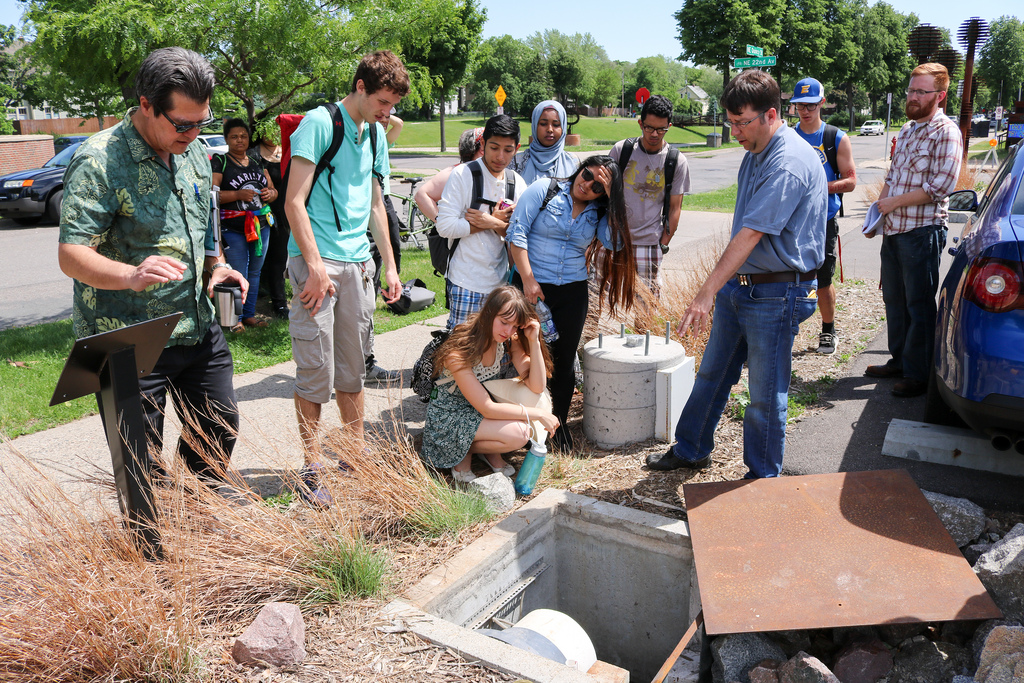
From the beginning, one of our most important goals has been to help the school incorporate its new green campus features into its science curriculum. The stormwater best management practices (BMPs) at Edison offer students a unique opportunity to observe, interact and engage with natural processes that can help illustrate key concepts in science.
While the campus renovations were still underway, MWMO staff worked with teachers from the school’s International Baccalaureate (IB) science classes to use the BMPs as teaching tools. The teachers encouraged their students to make use of the BMPs in their class projects and use them to explore humans’ impact on the environment in urban areas.
The students used rainfall data, collected at the site, and characteristics of the parking lot to estimate the volume of stormwater that would run off into the tree trench. Based on the basics of how the tree trench works, they estimated how much pollution it would remove. In preparing for the exercise, MWMO assisted the teachers in determining which equations to use in best making the estimates, as well as providing information on the tree trench’s design and how much of the parking lot actually drains to it. Staff joined the students during their lesson to support them in their learning, and showed off how we are collecting data on the system through our monitoring efforts.
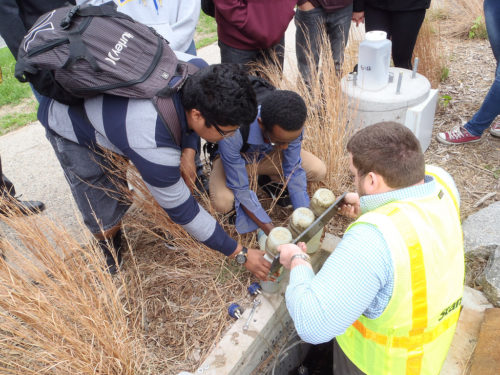
The work with the IB science classes continues to this day, and other teachers are now embracing the green campus features as well. This spring, Principal Eryn Warne organized a professional development day for teachers to help familiarize them with how the stormwater BMPs work. MWMO staff facilitated the event, the goal of which was to help make faculty more comfortable teaching their students about the science of stormwater management at Edison.
Science teachers at Edison have also partnered with Spark-Y on a new program called LEEF (for “Leadership, Entrepreneurship, Environment, Future”), which brings the school’s community garden and other green campus features into classroom learning. This fall, the LEEF chemistry course will be using data collected at the tree trench in a unit focused on the physical properties of materials. Students will be estimating the filtering capacity of the tree trench media and estimating the lifespan of the trench.
For MWMO staff, it has been gratifying to see the school take the lead role in bringing the green campus infrastructure into the classroom. But Edison students aren’t the only ones who stand to learn new things from their green campus. As an example, the MWMO recently gave a tour to a group of students from the University of St. Thomas, who used it as a case study of how to integrate a school’s infrastructure into a science curriculum. The UST students are actually teachers at other schools, learning how to integrate STEM topics into their classrooms. Their experience of working with the MWMO on this project is just another example of how our investments at Edison offer lessons for all kinds of students.
Using Real-Time Monitoring Data for Education
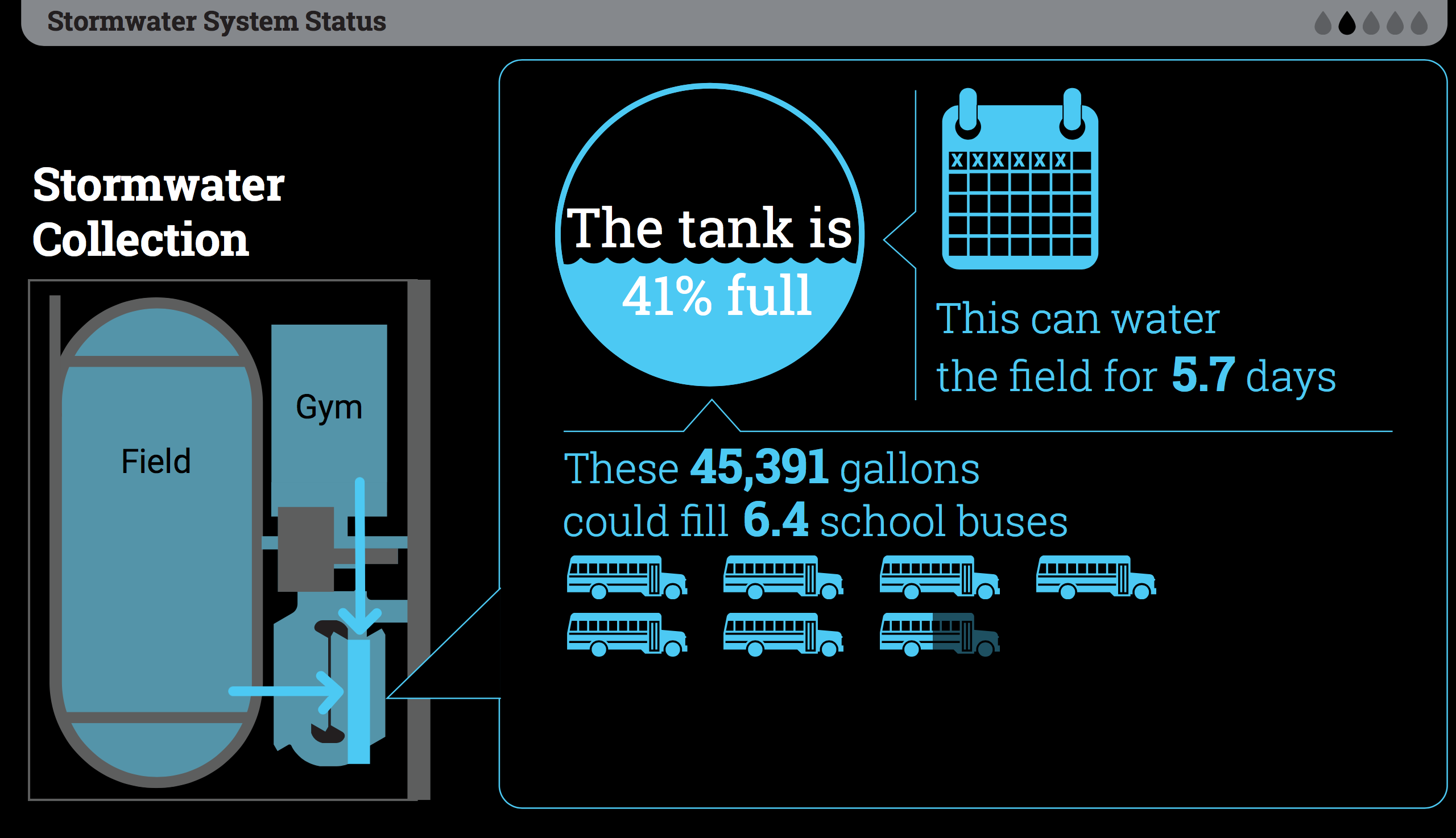
The centerpiece of the Edison Green Campus is the school’s stormwater reuse system, which irrigates the school’s athletic field using captured runoff. The system captures and stores runoff from three distinct surfaces around the field: the gymnasium rooftop, a plaza, and the field itself. Each of these surfaces produces different amounts and quality of stormwater runoff, which we can observe by monitoring them via a suite of sensors.
From the beginning, we sought to find a way to leverage this monitoring data as an educational tool. We worked with engineers and designers to find a way to display the results from the monitoring system in real time. The challenge was twofold: first, we needed a way to display how much water the system was using; second, we needed to make that data understandable and relatable to a non-technical audience.
Getting this system up and running took a bit more work than initially expected, but earlier this year the school’s digital interpretive signage officially came online. A TV screen located in the concessions building (next to the school’s athletic field) now displays continuously updated data from the reuse system, showing students and visitors how much stormwater has been captured and reused. This digital signage is now fully functional, available on the web and accessible to all. (Note: The signage may not be updated during winter months, when the irrigation system is not in use.)
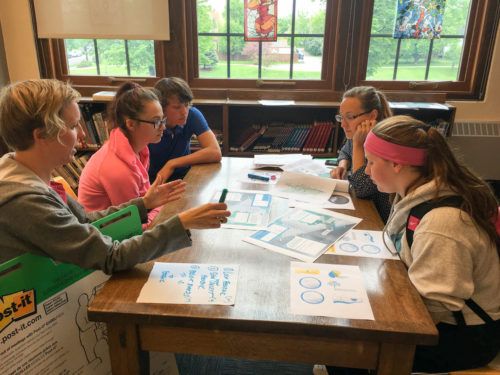
Interpretive signage has been a key to bringing stormwater concepts into the classroom at Edison, and the design process began with the students themselves. The MWMO worked with designers at Landbridge Ecological (formerly Wetland Habitat Restorations) to recruit students to participate in a series of design workshops. The designers enlisted the students’ help in crafting language and graphics that could explain the green campus features in terms that would speak to their peers — young people with diverse backgrounds, including non-native English speakers.
The result is a series of visualizations that use colorful graphics and simple concepts to convey meaning. Rather than stating, “Our cistern collected 164,148 gallons of stormwater this week,” the signage puts that information into context. It answers questions like: How long can the field be irrigated using that water? How many school buses would that water fill? How much money does the school save by reusing that amount of water?
The students’ insights were invaluable in crafting the final graphics, which were used to create both the digital signage and the static signs that are displayed prominently around campus. The designs were also repurposed for use in the Edison Green Campus Field Guide. Originally created as a handout for the ribbon-cutting ceremony, the booklet has since been reprinted and is now used by teachers at Edison.
Monitoring Stormwater BMP Performance at Edison
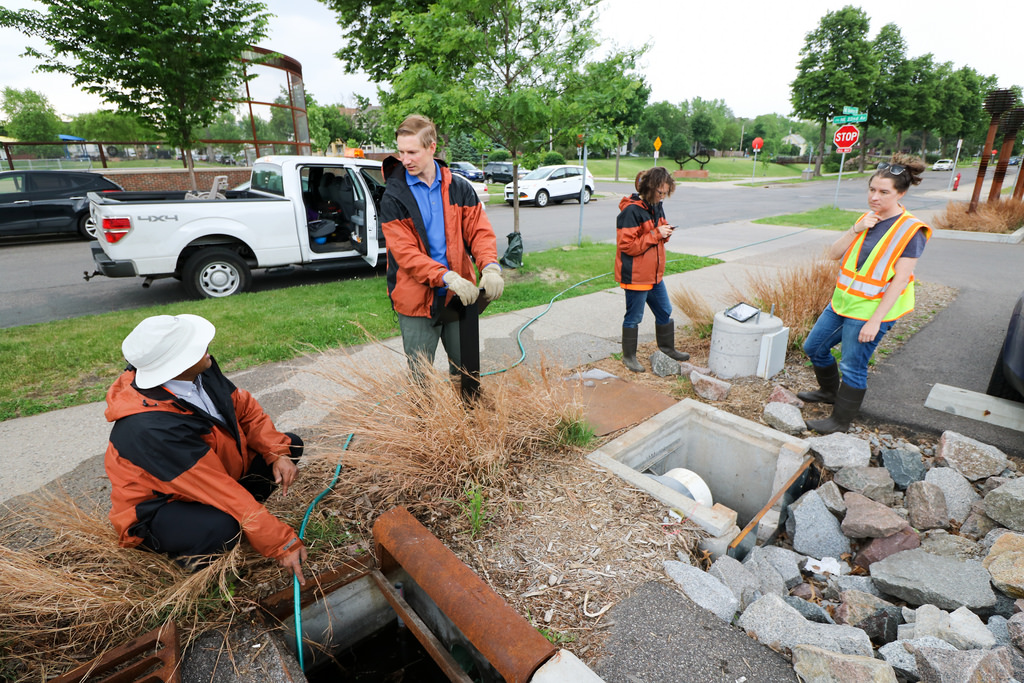
The school’s irrigation system isn’t the only feature we’re monitoring at Edison. Our team has also been collecting data on the performance of the tree trench installed in the school’s parking lot. In addition to providing unique educational opportunities for the students, the data collected from these systems provides our staff with insights on the effectiveness of the BMPs.
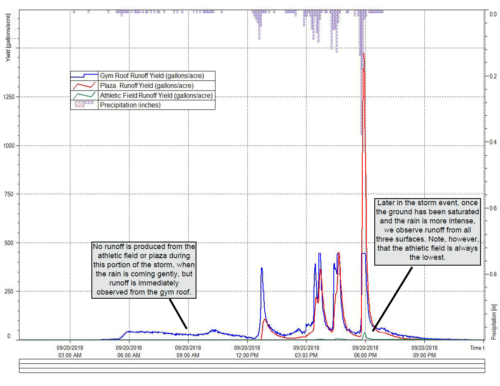
The plot on the right shows some of the data we’ve collected from the reuse system connected to the athletic field. It highlights how runoff is generated on the different surface types we’re monitoring. The amount of precipitation (in this case, rain) that was recorded is shown along the top of the plot and labeled on the right axis. The amount of water that was recorded running off of each of the surfaces is shown along the bottom of the plot and labeled on the left axis. Note that even small amounts of rain generate runoff from the gymnasium rooftop, while it takes more (and more intense) rainfall to generate flow from the plaza and athletic field. This observation verifies the concept that hard surfaces (i.e. the gymnasium rooftop) create more runoff than grassed areas (the athletic field).
Now let’s look at some data from the tree trench in the school’s parking lot. By collecting water quality samples and monitoring flow, we’ve gained some insights into how well the tree trench is functioning.
The MWMO has monitoring equipment installed at both the inlet and outlet of the Edison tree trench. We’ve been collecting data on both the quantity and quality of stormwater that enters and exits the trench since 2015. We also have monitoring locations within the tree trench, where we can observe the level (i.e., depth) of stormwater inside the BMP.
The data we’ve collected to date shows us the Edison tree trench is definitely doing its job. During the time we’ve been monitoring, we’ve never actually seen stormwater exit the system. Instead, it runs off the parking lot, into the BMP and fully infiltrates into the ground. We estimate that from May through mid-September of 2018, the Edison tree trench captured and infiltrated over 112,000 gallons of stormwater, stopping about 0.2 pounds of phosphorus from draining to the river.
Beyond Edison: New Green Campuses Emerge
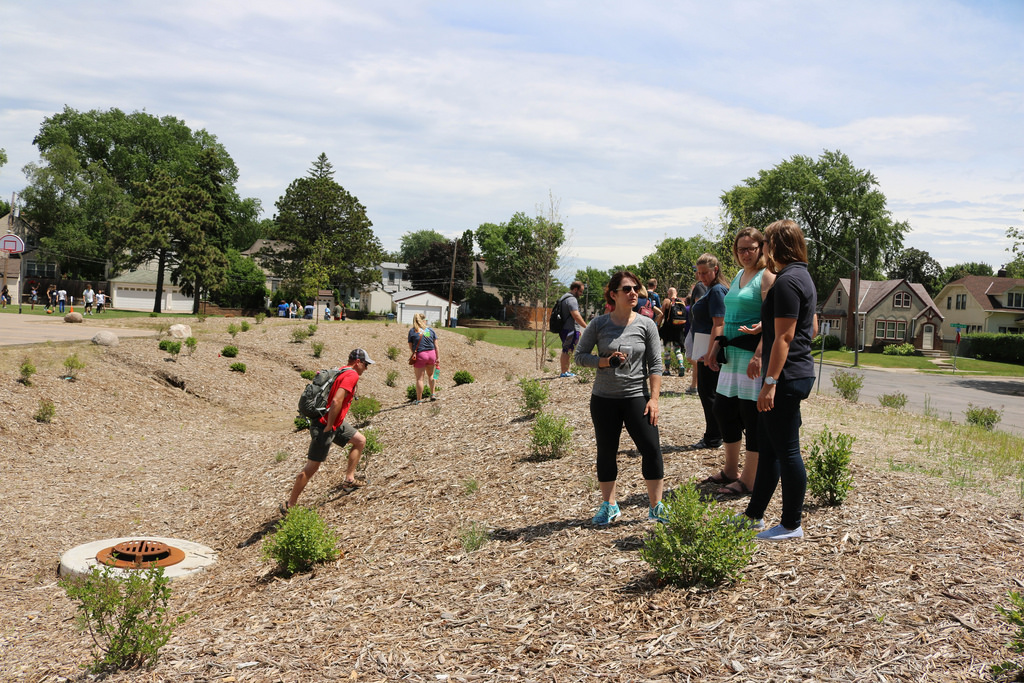
The Edison High School Green Campus has become a model for other schools, and several have already sought to emulate Edison’s success. Northeast Middle School, a feeder school for Edison, launched its own green campus initiative. With support from the MWMO and the Audubon Neighborhood Association, it constructed a large raingarden and installed interpretive signage designed with student input and by the same design team behind the signs at Edison. Hiawatha Collegiate School, inspired by Edison’s green campus, sought the MWMO’s help to install a stormwater reuse system of its own earlier this year. The MWMO is currently in discussions with other schools about bringing similar stormwater BMPs to their campuses.
Even the interpretive signage at Edison has taken on a life of its own, spawning a library of stormwater graphics that have been employed at Northeast Middle School and several other MWMO project sites. The success of the Edison Green Campus Field Guide also led directly to the creation of the MWMO’s new Good Neighbor Guide, which imitates its style and substance. And the school’s digital signage has inspired Westminster Presbyterian Church to similarly incorporate live data from its reuse system into interpretive displays for its visitors.
Edison’s green transformation was a team effort — the result of a partnership between the school, the MWMO, the Holland Neighborhood Improvement Association, the City of Minneapolis, Minneapolis Public Schools, Spark-Y and an array of talented designers, engineers and builders. We’re proud to have played a role in setting a new standard for green infrastructure at schools, and we look forward to continuing our efforts to use that infrastructure as a tool for hands-on learning and community outreach.



